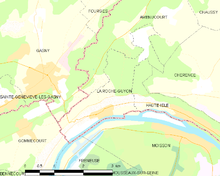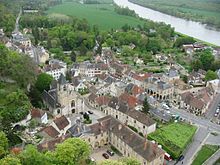La Roche-Guyon
La Roche-Guyon | |
|---|---|
 La Roche-Guyon, the castle and the keep | |
| Coordinates:49°04′56″N1°37′49″E/ 49.0822°N 1.6303°E | |
| Country | France |
| Region | Île-de-France |
| Department | Val-d'Oise |
| Arrondissement | Pontoise |
| Canton | Vauréal |
| Intercommunality | Vexin Val de Seine |
| Government | |
| • Mayor(2020–2026) | Capucine Faivre[1] |
| Area 1 | 4.61 km2(1.78 sq mi) |
| Population (2021)[2] | 448 |
| • Density | 97/km2(250/sq mi) |
| Time zone | UTC+01:00(CET) |
| • Summer (DST) | UTC+02:00(CEST) |
| INSEE/Postal code | 95523/95780 |
| Elevation | 13–143 m (43–469 ft) |
| 1French Land Register data, which excludes lakes, ponds, glaciers > 1 km2(0.386 sq mi or 247 acres) and river estuaries. | |



La Roche-Guyon(French pronunciation:[laʁɔʃɡɥijɔ̃]) is acommunein theVal-d'OisedepartmentinÎle-de-Francein northernFrance.[3]It is located in theVexin regional nature park.
The commune grew around theChâteau de La Roche-Guyon,upon which historically it depended for its existence. The commune's population in 2019 was 479.
Geography[edit]
It is located approximately 58 km fromParisand 9 km from Giverny
Château de La Roche-Guyon[edit]
The present Château de La Roche-Guyon[4]was built in the 12th century, controlling a river crossing of theSeine,itself one of the routes to and fromNormandy;[5]TheAbbé Sugerdescribed its grim aspect: "At the summit of a steep promontory, dominating the bank of the great river Seine, rises a frightful castle without title to nobility, called La Roche. Invisible on the surface, it is hollowed out of a high cliff. The able hand of the builder has established in the mountainside, digging into the rock, an ample dwelling provided with a few miserable openings".[6]In the mid-13th century, a fortifiedmanor house(thechâteau-bas) was added below. Guy de La Roche fell at theBattle of Agincourt,and his widow was ousted from the Roche, after six months of siege, in 1419; she preferred to depart rather than acceptHenry V of Englandas her overlord.
James V of Scotlandand his brideMadeleine of Valoisstayed for two nights in March 1537.[7]The Château came to theLiancourtfamily with the marriage of Roger de Plessis-Liancourt to the heiress Marie de La Roche; he was a childhood companion ofLouis XIII,first gentleman of theChambre du Roi,and was made a duke in 1643. He and his wife made great changes to thechâteau-bas,opening windows in its structure and laying out the terrace to the east, partly cut into the mountain's steep slope.
The domain of La Roche-Guyon came to theLa Rochefoucauldfamily in 1669, with the marriage of Jeanne-Charlotte de Plessis-Liancourt with François VII de La Rochefoucauld. The Château retained its medieval aspect of a fortress, with its moat and towers and cramped, dark living apartments. The Château was largely extended in the 18th century.
WhenTurgot,the minister ofLouis XVI,failed in his schemes for fundamental reforms in 1776, he retired to the Château briefly, as the guest of Louise Elisabeth Nicole de La Rochefoucauld, Duchesse d'Enville.
La Roche Guyon was the birthplace ofFrançois Alexandre Frédéric, duc de la Rochefoucauld-Liancourt(1747–1827).
InWorld War II,the château was a headquarters for GermanField MarshalErwin Rommel(1891–1944). AfterD-Day,he defendedNormandyagainst theAlliesinWorld War IIfrom abunkerlocated here.
In 1962, the castle was used as a setting for the medieval segment of theBelgian comicon time travel:Le Piège Diabolique(The Time Trap) of theBlake and Mortimerseries byEdgar Pierre Jacobs.
After 1990, restorations and archaeological surveys undertaken by theConservatoire régional des Monuments historiquesrevealed new additions to the documentary history of La Roche-Guyon, undertaken in the 19th century by Hippolyte Alexandre and Emile Rousse.
In early 1960, French technocrats had the idea for a new administrative capital, to replace Paris as capital with a French "Brasilia"built near La Roche-Guyon and to transform the commune into a" Monaco on the Seine ". In early 1960, there was an architectural design competition for the Project, in which the architectsAlbert Lapradeand Jean Brasilier participated.[citation needed]
The castle is opened to the public and several events take place there (Fête des Fleurs, Salon du Vin etc.)
The village is protected on its architecture (as La Roche-Guyon is locate in the Vexin Regional Park)
Several shops contribute to make the village lively with its restaurants, cafés and tea houses.
Points of interest[edit]
See also[edit]
References[edit]
- ^"Répertoire national des élus: les maires"(in French). data.gouv.fr, Plateforme ouverte des données publiques françaises. 4 May 2022.
- ^"Populations légales 2021"(in French).The National Institute of Statistics and Economic Studies.28 December 2023.
- ^INSEE commune file
- ^Its early seigneurs, vassals of the comtes deMeulan,traditionally bore the nameGuy;La Roche-Guyon signifies the "Rock of Guy"
- ^A 9th-century document leads historians to believe that the site was already fortified as part of the defences againstVikingmarauders who used the Seine as a pathway upriver toParis(Le Ménestrel du Vexin).
- ^Suger,Vie de Louis VI,"Au sommet d'un promontoire abrupt, dominant la rive du grand fleuve de Seine, se dresse un château affreux et sans noblesse appelé La Roche. Invisible à sa surface, il se trouve creusé dans une haute roche. L'habile main du constructeur a ménagé sur le penchant de la montagne, en taillant dans la roche, une ample demeure pourvue d'ouvertures rares et misérables."
- ^James Balfour Paul,Accounts of the Treasurer of Scotland,vol. 7 (Edinburgh, 1907), p. 19.
External links[edit]
- Official website(in French)
- Château de la Roche-Guyon: Official website(in French)
- Base Mérimée:Search for heritage in the commune,Ministère français de la Culture.(in French)
- Association of Mayors of the Val d'Oise(in French)
- "La duchesse d'Enville à la Roche-Guyon"
- History of the castle of the Roche Guyon(French)




